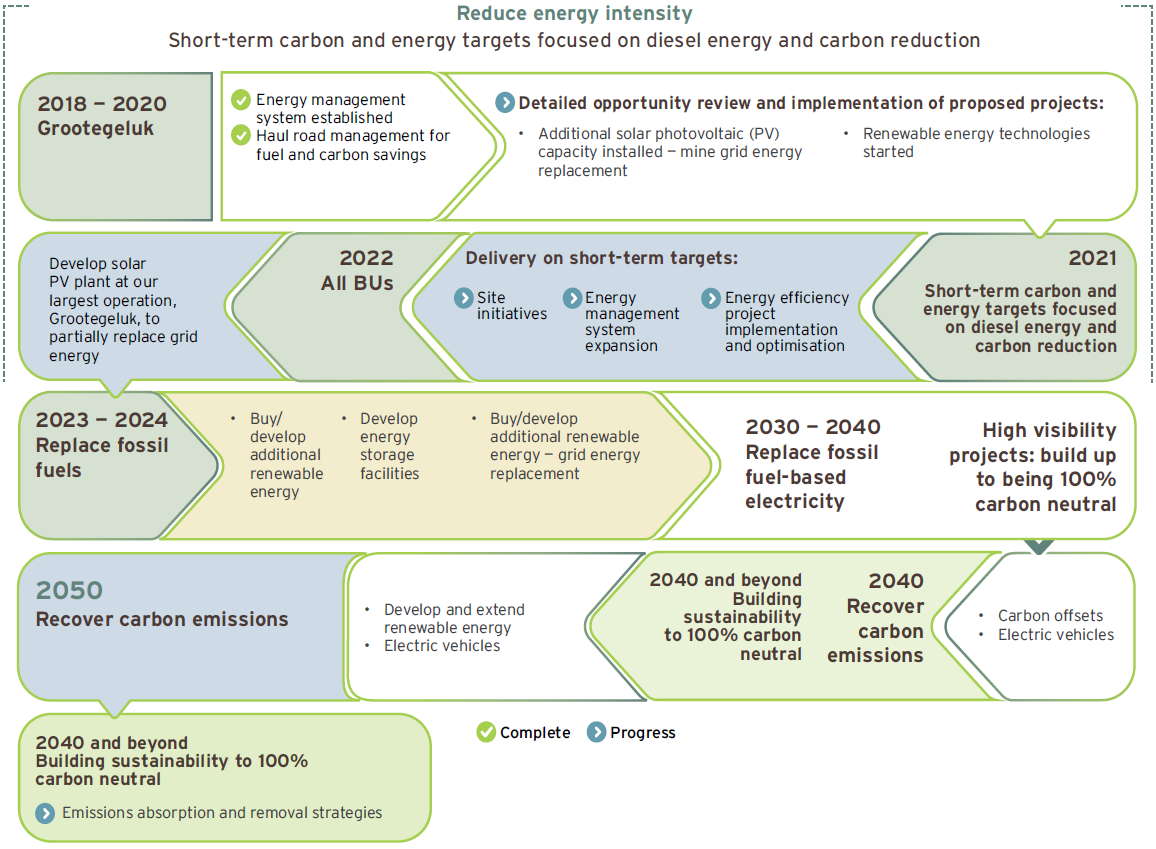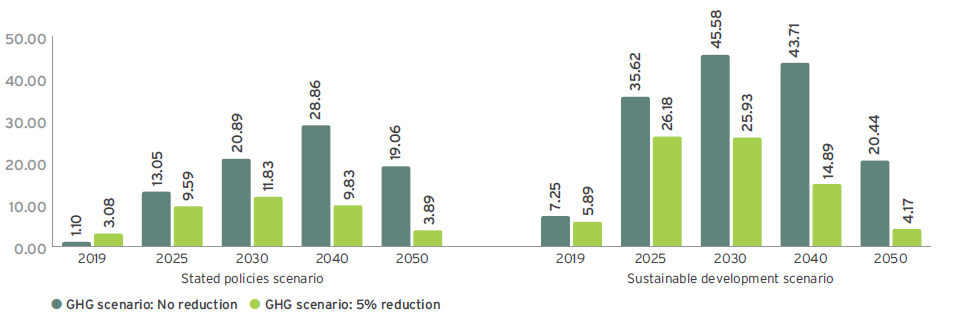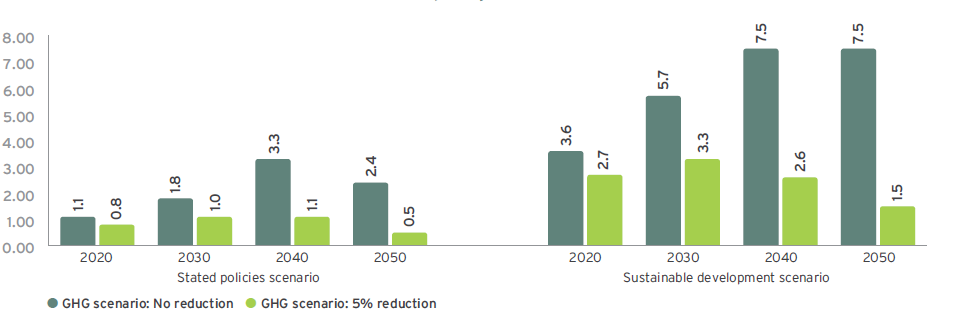Transitioning our business is a direct response to the threat of climate change. We aim to achieve our goal of being carbon neutral by 2050 in a just manner. We are transitioning into a resilient, diversified resources business and decarbonising our portfolio.
Our response includes leveraging opportunities, managing risks, adapting and responsibly operating in a carbon-constrained economy, considering:

Our approach is guided, informed and executed by:
Shifting our business portfolio to more climate resilient businesses, with a focus on renewable energy and a continued review of minerals contributing to a low-carbon world.
The TCFD provides a strategic framework for guiding our Climate Change Response strategy.
![]() TCFD index (refer to the
databook)
TCFD index (refer to the
databook)
Our Climate Change Response strategy supports our overarching Sustainable Growth and Impact strategy specifically through three of the five objectives:
To actively reduce scope 1 and 2 emissions by 40% by 2026, we address three primary areas:
Details on our efforts to reduce
scope 3 (indirect) GHG emissions
are outlined in ![]() climate change resilience
climate change resilience
In March 2020, we communicated
our position on climate change
clearly in our ![]() climate change position
statement (sustainability tab)
climate change position
statement (sustainability tab)
Our board applies good corporate governance to ensure sustainable growth while transitioning to a low-carbon world, an ethical culture and delivering on the promise of human rights
![]() Climate-related risks
and opportunities
are considered as part of our
enterprise risk management (ERM)
processes, which strive to embed
risk management into existing
processes to support informed
decision making. A detailed climate
change scenario analysis was
undertaken in 2019 and 2020.
Climate-related risks
and opportunities
are considered as part of our
enterprise risk management (ERM)
processes, which strive to embed
risk management into existing
processes to support informed
decision making. A detailed climate
change scenario analysis was
undertaken in 2019 and 2020.
GHG Protocol
Exxaro measures, manages and reports energy and carbon data in terms of the GHG Protocol.
CDP
We have participated in the CDP climate change programme since 2008.
We aim to support our objectives by creating partnerships that drive climate action and raise employee awareness of climate change mitigation and adaptation.
* We published our Climate Change Response strategy and assessment on our alignment with the TCFD recommendations in our 2020 Climate Change Response strategy report.
Our commitment to climate change and decarbonisation reaches every area of our ESG approach and impacts all our business activities.



To deliver these focus areas, Exxaro established a decarbonisation project management office and interconnected workstreams. Each has a clear mandate (as below), and ownership at executive level to ensure accountability and delivery.

Integrate carbon neutral KPIs in organisational portfolio and capital allocation decisions

Investigate how the decarbonisation plan can be integrated into our community development projects
Investigate climate-smart technologies to reduce water, energy and waste risk, and develop an implementation approach for the group
Investigate our GHG exposure for agriculture, forestry and other land use sectors, and develop a decarbonisation plan that considers future land use activities
Investigate global and local climate financing, and determine how to leverage our decarbonisation plan
Develop a legal review instrument to track climate legislation across jurisdictions which influence and impact on Exxaro
Identify climate change risks and opportunities within our inbound and outbound logistics, and develop a mitigation plan
Work with the Exxaro university chairs to develop tailored climate change training and awareness material for employees and communities
Support the streams by coordinating operational teams to provide data and develop site-specific execution plans
Engage and collaborate with end-customers to reduce climate change risks by reducing scope 3 emissions
Work closely with the stream lead and technical committee to develop a system‑based decarbonisation model that will integrate all internal and external dimensions to support operational and strategic decision making for the group
Our board and its committees are ultimately accountable and responsible for responding to climate change, and therefore to ensure management addresses climate change, among other material ESG matters, and ensures integrated business processes and responses. Board responsibilities and activities include:
Our board and management monitor our performance against climate change goals as part of the regular internal reporting process. Additional sessions inform our board and management of emerging trends, risks and opportunities. Climate change matters that relate to committees' terms of reference are discussed at each meeting.
The board has delegated responsibilities for ongoing management of climate change risks and opportunities to the RBR committee (to emphasise climate change issues) and the SERC (to ensure we adhere to just transition principles). These committees meet quarterly and review progress in mitigation, adaptation, leveraging of opportunities and community engagement on climate change risks. The board chairperson attends the RBR committee meetings and ensures that the board is aware that climate change risks are a business imperative that requires urgent and unequivocal wide-ranging collective action by governments, businesses and civil society.
To enhance our effectiveness as we gear up for our transition, and coordinate our internal and external responses, we have established an ESG steering committee, reporting to our executive committee on ESG performance, measurement and improvements. To ensure alignment with our carbon emissions reduction goals, the ESG steering committee oversees energy management projects and activities. This helps us understand risks and opportunities so that our operations can focus on managing energy consumption, carbon emissions and other climate-related matters.
Our board and management are committed to understanding and embracing the science behind climate change. ![]() Governance
Governance

Climate change-related risks and opportunities are part of our ERM processes; a strategic initiative fully supported by the board and executive management.
We conducted a detailed climate change scenario analysis in 2019 and 2020 to identify these risks and determine their relative significance.
1 Credit and insurance risk
Financial institutions are increasingly moving away from funding companies with high climate change risk exposure and intangible carbon reduction targets. Globally, funding of coal-related operations is being diverted to investment that supports a low-carbon economy. Locally, some major commercial banks have indicated that they will no longer fund new coal projects. The financial institutions are increasingly evaluating the impacts of climate change scenarios on borrowers' revenues, costs and property values, and how this could affect the probability of default and loan-to-value ratios at a borrower and portfolio level. This sentiment is likely to grow in the five to 10 years as action to mitigate climate change impacts increases. To manage this risk, the Sustainable Growth and Impact strategy is focused mainly on new renewable generation and minerals that can facilitate a cleaner future. This strategy was presented at our Capital Markets Day in 2021 and many financiers indicated their interest in this new business direction, mitigating some of the financial lending risk.
Over the past five years we have noted a significant increase in our insurance premiums against our assets. This scenario is likely to increase as climate action intensifies.
2 Carbon pricing risk
The South African government is implementing policy measures to reduce its GHG emissions to meet its Paris Agreement commitments. The government implemented the carbon tax in June 2019 to encourage corporate behaviour to direct investments and expenditure towards low-carbon alternatives.
The nominal tax rate is R144/tCO2e. However, government allows specific tax-free allowances to facilitate a smooth transition to a low-carbon economy and mitigate competition among affected industries, reducing the rate to between R7 and R58/tCO2e. The carbon tax is based on fossil fuel inputs (such as coal, oil and gas use), and applies to entities with a total minimum installed thermal capacity of 10MW.
The first phase of the carbon tax (up to 2025) is not designed to affect the electricity price but to address concerns raised by the mining sector. National Treasury has been reviewing the impact of the carbon tax, its rates and tax-free threshold levels on business. Our scenario analysis predicts an increase, in line with an international trend, in the South African carbon price. We expect the South African government to increase efforts to meet its Paris Agreement commitments (nationally determined contribution) to transition the South African economy.
Our TCFD analysis also identified increased carbon pricing and operating costs (such as higher compliance costs) as examples of climate-related policy risk. Carbon prices associated with emissions trading schemes, carbon taxes, fuel taxes and other policies are expected to rise as government reduces GHG emissions in line with the Paris Agreement. The speed and rate of carbon price increases are uncertain and likely to vary across countries and regions. Our scenario analysis of carbon price risk exposure below shows the expected outcome based on the stated policies and sustainable development scenarios.
Carbon pricing risk exposure (US$m)

Projected increase in operating expenditure due to carbon pricing risk (% change)

3 Market risk
One of the major ways in which markets can be affected by climate change is through shifts in supply and demand for certain commodities, products and services as climate-related risks and opportunities are increasingly taken into account. The shift in fossil fuel and energy markets will have implications for our business portfolio resilience and transitioning process. Further, we also appreciate that climate change has created new markets, increased emissions reduction technology demand and supply, presented new financial instruments, and renewed efforts to mitigate fossil fuels and potential financial impacts on the business.
4 Reputation risk
Climate change has been identified as a potential source of reputational risk tied to changing stakeholder perceptions (investors, customers, communities, non-governmental organisations (NGOs) and government) of an organisation's contribution to or detraction from the transition to a lower-carbon economy. We are aware that the mining sector at large is exposed to the reputational risk of climate change - a threat to the credibility of its efforts to reposition itself as a more sustainable sector, and by extension to its licence to operate.
Our approach has been to genuinely commit to climate action, sustainability, accountability and transparency, as well as implementing adequate mitigation, adaptation, governance, risk and communications strategies to ensure a sustainable future for Exxaro and our stakeholders.
5 Water security risk
Climate change physical impacts, such as increasing temperatures, rising sea levels, and more frequent or intense droughts, more frequent and more damaging floods and storms, are serious challenges for our facilities, supply chains, employees, current and potential customers, and our host communities.
Water security is the backbone of Exxaro's water strategy which was revised in 2017 to reduce our risk. The fundamental principle of our water management approach is sustainable use of water resources and to become a net positive water contributor to the natural system. The risk of water security is increased significantly at our Waterberg operation due to lack of perennial water basins. Our Waterberg operation currently has a negative water balance as they rely on an external source for their operational water requirements.
Exxaro's flagship mine, Grootegeluk, is situated in the Waterberg region. It relies on the Mokolo Crocodile West Augmentation Project phase 1 water supply scheme for reliable water supply. Water from the Mokolo Dam is supplied via a 46km pipeline to the Lephalale area for the town, Eskom and Exxaro. The system can supply 30 million m3 of water per year. Refer to  water security management.
water security management.
6 Risk of heatwaves at our operations
Heatwaves are events where the maximum temperature at a given location exceeds the average maximum temperature of the year's warmest month by 5°C or more for at least three consecutive days. Downscaled climate models show that the Waterberg complex is predicted to experience a relatively higher number of average heatwave days than other Exxaro assets in Mpumalanga. The Waterberg operation will experience between 14 and 19 heatwave days from 2021 to 2040 (relative to 1961 to 1980). Our Mpumalanga operations are predicted to experience between eight and 13 heatwave days for the same period. This risk of heatwaves increases between 2041 and 2060 with Waterberg and Mpumalanga operations predicted to experience heatwave days of between 20 and 26, and 14 and 19 days respectively. An increase in heatwaves could result in negative health and safety impacts for employees, can create occupational health risks such as heat stroke, and restrict employees' physical functions and capabilities. Our proposed actions will enable employees and the business to cope with heat stress, and include developing workplace policies and guidelines that consider the health and safety of workers during heatwaves, with appropriate prevention and adaptation measures.
7 Risk of drought
The Global Climate Index model downscaling shows that north-eastern South Africa is projected to be generally drier from 2021 to 2040 (relative to the baseline period from 1961 to 1980). The model predicts that the western parts of southern Africa will experience increased rainfall over the same period. An increase in extreme rainfall events is projected to occur over the western interior and eastwards over the eastern escarpment areas as well as southern Mozambique. The average drought index per year for each time period is measured on a scale of 0 to 10, with 10 being the highest level of drought severity, according to the Keetch-Byram Drought Index. The Grootegeluk complex is in an area predicted to experience a higher level of drought severity than Exxaro's other sites - a trend that will increase over time. The increasing frequency of drought, particularly in the Waterberg, will increase our water security risks.
8 Risk of extreme rainfall days
On 13 March 2014, the Waterberg region received an unprecedented high rainfall in a 24-hour period, which led to operational interruption for five days. The flood event had a severe impact on our operations in terms of infrastructure damage, supply chain interruption, production stoppages, and employee and community safety. The frequency of extreme rainfall events is expected to increase in our Mpumalanga region.
Grootegeluk is in an area predicted to experience fewer average extreme rainfall days than Exxaro's other sites. The average number of extreme rainfall days is expected to increase across all sites towards 2060.
![]() 2020 Climate Change Response strategy report (2020 investor tab) and 2020 climate change position statement (sustainability tab)
2020 Climate Change Response strategy report (2020 investor tab) and 2020 climate change position statement (sustainability tab)
 Report Index
Report Index